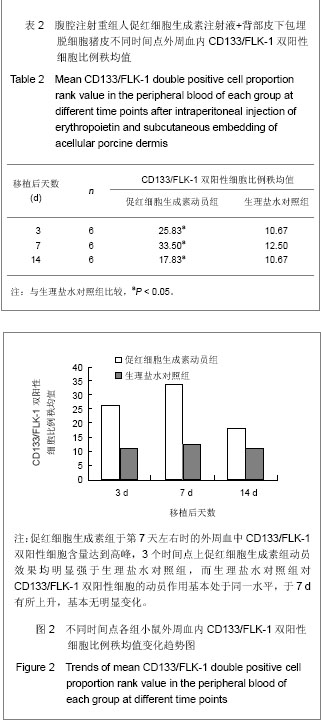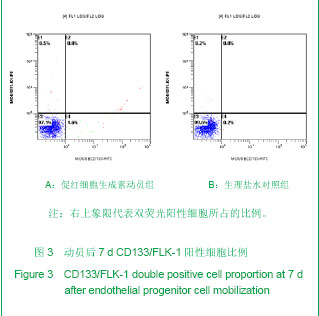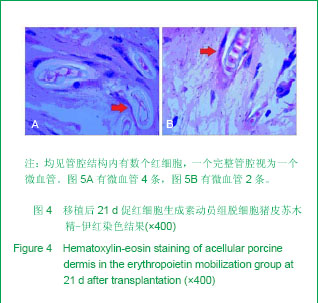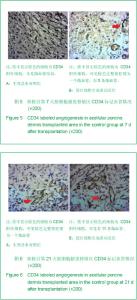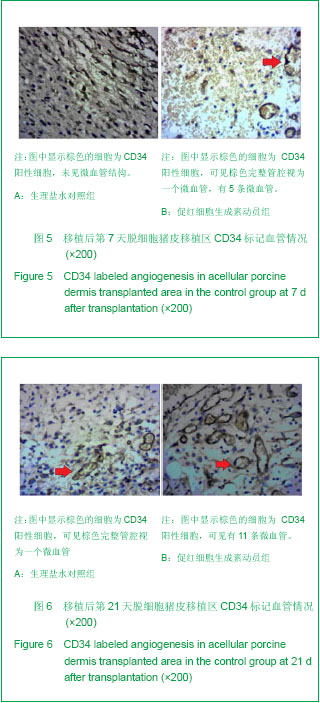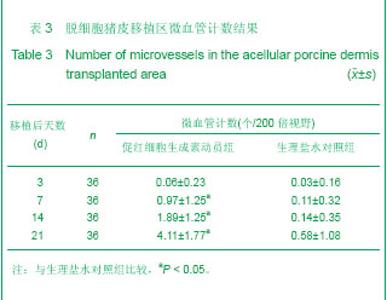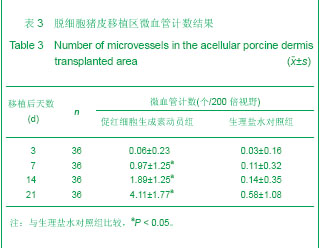Chinese Journal of Tissue Engineering Research ›› 2013, Vol. 17 ›› Issue (24): 4386-4393.doi: 10.3969/j.issn.2095-4344.2013.24.003
Previous Articles Next Articles
Angiogenesis of dermal scaffold transplantation zone promoted by moboilizing endothelial progenitor cells
Zhang Wei, Cai Di-xin, Wang Hong, Zhu Yong-cui
- 1 Department of Burn, the First Affiliated Hospital of Wannan Medical College, Wuhu 214000, Anhui Province, China
2 Department of Burn, the Second Affiliated Hospital of Kunming Meidical University, Kunming 650101, Yunnan Province, China
-
Received:2012-10-30Revised:2013-01-14Online:2013-06-11Published:2013-06-11 -
Contact:Wang Hong, Master’s supervisor, Chief physician, Department of Burn, the Second Affiliated Hospital of Kunming Meidical University, Kunming 650101, Yunnan Province, China ynwh631015@sina.com -
About author:Zhang Wei★, Master, Physician, Department of Burn, the First Affiliated Hospital of Wannan Medical College, Wuhu 214000, Anhui Province, China jlve@163.com -
Supported by:National Natural Science Foundation of China, No. 30760260*; Science and Technology Planning Project of Yunnan Province, No. 2007C247M*
CLC Number:
Cite this article
Zhang Wei, Cai Di-xin, Wang Hong, Zhu Yong-cui. Angiogenesis of dermal scaffold transplantation zone promoted by moboilizing endothelial progenitor cells[J]. Chinese Journal of Tissue Engineering Research, 2013, 17(24): 4386-4393.
share this article

2.1 实验动物基本情况 各组小白鼠体毛有光泽,反应敏捷,饮食正常,无意外死亡。 2.2 第一阶段实验CD133/FLK-1双荧光阳性细胞比例及变化趋势 生理盐水对照组在6个时间点双荧光阳性细胞比例差异均无显著性意义(P > 0.05)。低剂量促红细胞生成素动员组与高剂量促红细胞生成素动员组于动员后1,3,5 d双荧光阳性细胞比例逐渐增加,且于7 d达到高峰。自动员3 d起,各时间点3组间双荧光阳性细胞比例差异均有显著性意义(P < 0.05);高剂量促红细胞生成素动员组双荧光阳性细胞比例较低剂量促红细胞生成素动员组和生理盐水对照组增加明显 (P < 0.05);低剂量促红细胞生成素动员组双荧光阳性细胞比例较生理盐水对照组增加明显(P < 0.05),见表1和图1。 2.3 第二阶段实验CD133/FLK-1双荧光阳性细胞比例及变化趋势 生理盐水对照组在3个时间点双荧光阳性细胞比例差异均无显著性意义(P > 0.05);促红细胞生成素动员组各时间点组间双荧光阳性细胞比例差异均有显著性意义(P < 0.05)。促红细胞生成素动员组动员后3 d的双荧光阳性细胞比例逐渐增加且于7 d达到高峰。促红细胞生成素动员组双荧光阳性细胞比例较生理盐水对照组增加明显(P < 0.05)。行脱细胞猪皮移植未引起这种变化趋势改变,见表2和图2。 "
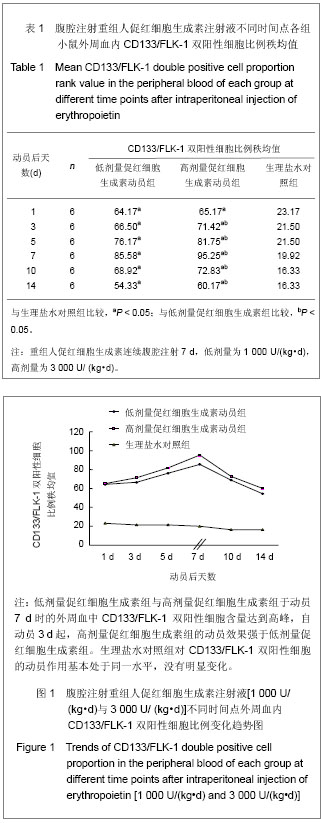
| [1] Fu JF,Chen B. Zhonghua Shunshang yu Xiufu Zazhi:Dianziban. 2011;6(1):16-19.付晋凤,陈斌.脱细胞真皮基质及其临床应用[J].中华损伤与修复杂志:电子版, 2011,6(1):16-19.http://www.cnki.net/KCMS/detail/detail.aspx?QueryID=6&CurRec=2&recid=&filename=ZHSX201101007&dbname=CJFD2011&DbCode=CJFQ&urlid=&yx=[2] Supp DM, Supp AP, Bell SM,et al. Enhanced vascularization of cultured skin substitutes genetically modified to overexpress vascular endothelial growth factor.J Invest Dermatol. 2000;114(1):5-13.http://www.ncbi.nlm.nih.gov/pubmed/10620108[3] Unger RE, Oltrogge JB, von Briesen H,et al. Isolation and molecular characterization of brain microvascular endothelial cells from human brain tumors.In Vitro Cell Dev Biol Anim. 2002;38(5):273-281.http://www.ncbi.nlm.nih.gov/pubmed?term=Isolation%20and%20molecular%20haracterization%20of%20brain%20micro-vascular%20endothelial%20cells%20from%20human%20rain%20tumors[4] Schultheiss D, Gabouev AI, Cebotari S,et al.Biological vascularized matrix for bladder tissue engineering: matrix preparation, reseeding technique and short-term implantation in a porcine model.J Urol. 2005;173(1):276-280.http://www.ncbi.nlm.nih.gov/pubmed?term=.Biological%20vseularized%20matrix%20for%20bladder%20tissue%20enginering%3BMatrix%20preparation%2Creseeding%20technique%20and%20short-term%20implantation%20in%20a%20poreine%20model[5] Butzal M, Loges S, Schweizer M,et al. Rapamycin inhibits proliferation and differentiation of human endothelial progenitor cells in vitro. Exp Cell Res. 2004;300(1):65-71.http://www.ncbi.nlm.nih.gov/pubmed/15383315[6]Wang DX,Zhang L,Fan KW,et al. Linchuang he Shiyan Yixue Zazhi. 2007;6(4):11-12.汪道新,张灵,范锟铻,等.人脐静脉血管内皮细胞移植对脱细胞猪真皮早期血管化的影响[J].临床和实验医学杂志,2007,6(4):11-12.http://www.cnki.net/KCMS/detail/detail.aspx?QueryID=7&CurRec=1&recid=&filename=SYLC200704004&dbname=cjfd2007&DbCode=CJFQ&urlid=&yx=[7] Zhou T,Wang YQ,Fu WG,et al. Shanghai:Fudan University. 2009:11-23.周涛,王玉琦,符伟国, 等. 促红细胞生成素联合基质细胞衍生因子-1在内皮祖细胞促血管新生中作用的研究[D].上海:复旦大学,2009:11-23. [8]Zheng PH,Huang YZ,Yang PD. Zhongguo Shiyan Xueyexue Zazhi. 2005;13(5):912-920.郑培浩,黄有章,杨平地.造血调控相关的细胞因子与血管内皮祖细胞[J].中国实验血液学杂志,2005,13(5):918-920.http://www.cnki.net/KCMS/detail/detail.aspx?QueryID=15&CurRec=1&recid=&filename=XYSY200505040&dbname=CJFD2005&DbCode=CJFQ&urlid=&yx=[9] Urao N, Okigaki M, Yamada H,et al. Erythropoietin-mobilized endothelial progenitors enhance reendothelialization via Akt-endothelial nitric oxide synthase activation and prevent neointimal hyperplasia.Circ Res. 2006;98(11):1405-1413.http://www.ncbi.nlm.nih.gov/pubmed/16645141[10] Le Minh K, Klemm K, Abshagen K,et al. Attenuation of inflammation and apoptosis by pre- and posttreatment of darbepoetin-alpha in acute liver failure of mice.Am J Pathol. 2007;170(6):1954-1963.http://www.ncbi.nlm.nih.gov/pubmed?term=Attenuation%20of%20inflammationandapoptosis%20by%20pre-and%20posttreatment%20of%20darbepoetinalpha%20in%20acute%20liver%20failure%20of%20mice[11] Zhou T,Wang YQ,Fu WG,et al. Shanghai:Fudan University. 2009:11-23.周涛,王玉琦,符伟国, 等. 促红细胞生成素联合基质细胞衍生因子-1在内皮祖细胞促血管新生中作用的研究[D].上海:复旦大学,2009:11-23.http://www.cnki.net/KCMS/detail/detail.aspx?QueryID=11&CurRec=1&recid=&filename=2009243193.nh&dbname=CDFD2010&DbCode=CDFD&urlid=&yx=[12] Hamed S, Ullmann Y, Masoud M,et al.Topical erythropoietin promotes wound repair in diabetic rats.J Invest Dermatol. 2010;130(1):287-294.http://www.ncbi.nlm.nih.gov/pubmed?term=Erythropoietin%20Promotes%20Wound%20Repair%20in%20Diabetic%20Rats[13] Sorg H, Krueger C, Schulz T,et al. Effects of erythropoietin in skin wound healing are dose related. FASEB J. 2009;23(9):3049-3058.http://www.ncbi.nlm.nih.gov/pubmed?term=Menger%2C%20Effects%20of%20erythropoietin%20in%20skin%20wound%20healing%20are%20dose%20related[14] Zhou QY,Cai WJ,Liao JM,et al. Jiepouxue Yanjiu. 2008; 30(6):435-437.周乾毅,蔡文佳,廖金敏,等.重组人促红细胞生成素对大鼠皮肤深Ⅱ°烫伤创面愈合的影响[J]. 解剖学研究,2008, 30(6):435-437.http://www.cnki.net/KCMS/detail/detail.aspx?QueryID=19&CurRec=1&recid=&filename=GDJP200806013&dbname=CJFD2008&DbCode=CJFQ&urlid=&yx=[15] Weidner N. Intratumor microvessel density as a prognostic factor in cancer. Am J Pathol. 1995;147(1):9-19.http://www.ncbi.nlm.nih.gov/pubmed/7541613[16] Yin AH, Miraglia S, Zanjani ED,et al. AC133, a novel marker for human hematopoietic stem and progenitor cells.Blood. 1997;90(12):5002-5012.http://www.ncbi.nlm.nih.gov/pubmed/9389720[17] Zhou B, Bi YY, Han ZB,et al. G-CSF-mobilized peripheral blood mononuclear cells from diabetic patients augment neovascularization in ischemic limbs but with impaired capability.J Thromb Haemost. 2006;4(5):993-1002.http://www.ncbi.nlm.nih.gov/pubmed?term=G-CSF%20mobilized%20peripheral%20blood%20mononuclearcells%20from%20diabetic%20patients%20augment%20neovas-cularization%20in%20ischemic%20limbs%20but%20with%20impaired%20capability.[18] Hirashima M, Kataoka H, Nishikawa S,et al. Maturation of embryonic stem cells into endothelial cells in an in vitro model of vasculogenesis.Blood. 1999;93(4):1253-1263.http://www.ncbi.nlm.nih.gov/pubmed?term=Maturation%20of%20embryonic%20stem%20cells%20into%20endothelial%20cells%20in%20an%20in%20vitro%20model%20of%20vasculogenesis[19] Harraz M, Jiao C, Hanlon HD,et al. CD34- blood-derived human endothelial cell progenitors.Stem Cells. 2001;19(4):304-312.http://www.ncbi.nlm.nih.gov/pubmed/11463950[20]Zhu HF,Xu XY. Zhongguo Yaolixue Tongbao. 2011;27(4):451-454.祝慧凤,徐晓玉,万东,等.促红细胞生成素促脑血管新生机制研究进展[J].中国药理学通报,2011,27(4):451-454.http://www.cnki.net/KCMS/detail/detail.aspx?QueryID=23&CurRec=1&recid=&filename=YAOL201104002&dbname=CJFD2011&DbCode=CJFQ&urlid=&yx=[21] Heeschen C, Aicher A, Lehmann R,et al. Erythropoietin is a potent physiologic stimulus for endothelial progenitor cell mobilization.Blood. 2003;102(4):1340-1346.http://www.ncbi.nlm.nih.gov/pubmed?term=Erythropoietin%20is%20a%20potent%20physiologic%20stimulus%20for%20endothelial%20progenitor%20cell%20mobilization[22]Yang RR,Xie P,Cheng Y. Disan Junyi Daxue Xuebao. 2010;32(7):647-650.杨瑞瑞,谢鹏,程焱. VEGF动员内源性EPCs促进MCAO/R小鼠神经功能恢复[J].第三军医大学学报,2010,32(7):647-650.http://www.cnki.net/KCMS/detail/detail.aspx?QueryID=27&CurRec=1&recid=&filename=DSDX201007008&dbname=CJFD2010&DbCode=CJFQ&urlid=&yx=[23] Cao D,Jiang M,Qiu M,et al. Huaxi Yaoxue Zazhi. 2005;20(6):563-564.曹丹,蒋明,邱萌,等. 大剂量rHuEPO改善肿瘤患者化疗后贫血的临床疗效[J]. 华西药学杂志,2005,20(6):563-564.http://www.cnki.net/KCMS/detail/detail.aspx?QueryID=37&CurRec=2&recid=&filename=HXYO200506041&dbname=CJFD2005&DbCode=CJFQ&urlid=&yx=[24] Srivastava A, Jennings LJ, Hanumadass M,et al.Xenogeneic acellular dermal matrix as a dermal substitute in rats. J Burn Care Rehabil. 1999;20(5):382-390.http://www.ncbi.nlm.nih.gov/pubmed?term=Xenogeneic%20acellular%20dermal%20matrix%20as%20a%20dermal%20substitute%20in%20rats[25] Guo X, Liu L, Zhang M,et al. Correlation of CD34+ cells with tissue angiogenesis after traumatic brain injury in a rat model.J Neurotrauma. 2009;26(8):1337-1344.http://www.ncbi.nlm.nih.gov/pubmed?term=orrelation%20of%20CD34%2B%20cellswith%20Tissue%20Angiogenesis%20after%20traumatic%20brain%20injury%20in%20a%20rat%20model[26] Eggermann J, Kliche S, Jarmy G,et al. Endothelial progenitor cell culture and differentiation in vitro: a methodological comparison using human umbilical cord blood.Cardiovasc Res. 2003;58(2):478-486.http://www.ncbi.nlm.nih.gov/pubmed/12757882[27] Schaum KD.Update on skin replacement and skin substitute application codes. Adv Skin Wound Care. 2006;19(2):86-90.http://www.ncbi.nlm.nih.gov/pubmed/16557054[28] Shevchenko RV, James SL, James SE. A review of tissue-engineered skin bioconstructs available for skin reconstruction.J R Soc Interface. 2010;7(43):229-258.http://www.ncbi.nlm.nih.gov/pubmed?term=A%20review%20of%20tissue-engineered%20skin%20bioconstructs%20available%20for%20skin%20reconstruction[29] Zhang GA, Ning FG, Zhao NM. Biomechanical properties of four dermal substitutes.Chin Med J (Engl). 2007;120(16):1454-1455.http://www.ncbi.nlm.nih.gov/pubmed?term=Biomechanical%20properties%20of%20four%20dermal%20substitutes[30] Dong L,Wang XS,Ma SY,et al. Zhongguo Zuzhi Gongcheng Yanjiu yu Linchuang Kangfu.2011;15(41):7631-7634.董丽,王旭昇,马绍英,等.组织工程皮肤的构建及组织形态学观察[J].中国组织工程研究与临床康复,2011,15(41):7631-7634.http://www.cnki.net/KCMS/detail/detail.aspx?QueryID=49&CurRec=1&recid=&filename=XDKF201141012&dbname=CJFD2011&DbCode=CJFQ&urlid=&yx= |
| [1] | Liu Cong, Liu Su. Molecular mechanism of miR-17-5p regulation of hypoxia inducible factor-1α mediated adipocyte differentiation and angiogenesis [J]. Chinese Journal of Tissue Engineering Research, 2021, 25(7): 1069-1074. |
| [2] | Chen Siqi, Xian Debin, Xu Rongsheng, Qin Zhongjie, Zhang Lei, Xia Delin. Effects of bone marrow mesenchymal stem cells and human umbilical vein endothelial cells combined with hydroxyapatite-tricalcium phosphate scaffolds on early angiogenesis in skull defect repair in rats [J]. Chinese Journal of Tissue Engineering Research, 2021, 25(22): 3458-3465. |
| [3] | Mo Jianling, He Shaoru, Feng Bowen, Jian Minqiao, Zhang Xiaohui, Liu Caisheng, Liang Yijing, Liu Yumei, Chen Liang, Zhou Haiyu, Liu Yanhui. Forming prevascularized cell sheets and the expression of angiogenesis-related factors [J]. Chinese Journal of Tissue Engineering Research, 2021, 25(22): 3479-3486. |
| [4] | Dai Min, Wang Shuai, Zhang Nini, Huang Guilin, Yu Limei, Hu Xiaohua, Yi Jie, Yao Li, Zhang Ligang. Biological characteristics of hypoxic preconditioned human amniotic mesenchymal stem cells [J]. Chinese Journal of Tissue Engineering Research, 2021, 25(19): 3004-3008. |
| [5] | Fan Feiyan, Zhang Yunke. Effect and mechanism of traditional Chinese medicine for replenishing qi and promoting blood combined with bone marrow mesenchymal stem cells in promoting angiogenesis in ischemic stroke [J]. Chinese Journal of Tissue Engineering Research, 2021, 25(13): 2060-2069. |
| [6] | Tao Guilu, Chu Tongbin, Zhang Lei. Proliferation and migration of endothelial progenitor cells promoted by bone marrow mesenchymal stem cells conditioned medium with rosiglitazone [J]. Chinese Journal of Tissue Engineering Research, 2021, 25(1): 56-60. |
| [7] | Xu Guofeng, Li Xuebin, Tang Yifan, Zhao Yin, Zhou Shengyuan, Chen Xiongsheng, Jia Lianshun. The role of autophagy in ossification of the human ligamentum flavum [J]. Chinese Journal of Tissue Engineering Research, 2020, 24(8): 1174-1181. |
| [8] | Yuan Yiming, Wang Yan, Chen Chengcheng, Zhao Mingyue, Pei Fei. Efficacy of exosomes in peripheral nerve injury [J]. Chinese Journal of Tissue Engineering Research, 2020, 24(31): 5079-5084. |
| [9] |
Geng Kang, Ding Xiaobin, Tian Xinli, Wang Xue, Yang Yuting, Yan Hong.
Electrical stimulation promotes wound healing and angiogenesis in diabetic rats [J]. Chinese Journal of Tissue Engineering Research, 2020, 24(26): 4152-4156. |
| [10] |
Hou Xiaolin, Liang Jun, Yang Cheng, Cui Meihua.
Co-transplantation of adipose mesenchymal stem cells and endothelial progenitor cells in ulcerative colitis mice [J]. Chinese Journal of Tissue Engineering Research, 2020, 24(25): 3981-3987. |
| [11] |
Xiang Haidong, Cheng Dongmei, Guo Han, Gao Qi .
Changes in the proliferation and angiogenesis of human dental pulp stem cells after treated with prostaglandin E1 combined with basic fibroblast growth factor [J]. Chinese Journal of Tissue Engineering Research, 2020, 24(25): 4006-4011. |
| [12] |
Feng Yuan, Han Zhiqi, Zhou Nuo.
Endothelial progenitor cells promote vasculogenesis and osteogenesis in the repair of bone defects [J]. Chinese Journal of Tissue Engineering Research, 2020, 24(25): 4046-4053. |
| [13] | Qin Yuxing, Ren Qiangui, Shen Peifeng. Superiority of tissue-engineered bone technology for treating bone defects [J]. Chinese Journal of Tissue Engineering Research, 2020, 24(24): 3877-3882. |
| [14] | Guo Wei, Lu Shan, Fan Hong, Li Jun. Alternative treatment for liver failure repair: current status and development countermeasures [J]. Chinese Journal of Tissue Engineering Research, 2020, 24(20): 3248-3255. |
| [15] | Cao Baichuan, Zeng Gaofeng, Gao Yunbing, Deng Guiying, Cen Zhongxi, Zhang Chuanyang, Guo Yande, Zong Shaohui. Heat-shock endothelial cells induce differentiation of bone marrow mesenchymal stem cells into vascular endothelial cells [J]. Chinese Journal of Tissue Engineering Research, 2020, 24(19): 3023-3028. |
| Viewed | ||||||
|
Full text |
|
|||||
|
Abstract |
|
|||||

